Application of RNN-LSTM in Predicting Drought Patterns in Pakistan: A Pathway to Sustainable Water Resource Management
Abstract
1. Introduction
- The paper’s main objective is to find the forecasting of water resources under climate change using the RNN-LSTM model;
- The other aim is to forecast the ground and surface water resources under climate change using the LSTM model.
2. Materials and Methods
2.1. Study Area
2.2. Datasets
2.3. Methodology
2.4. LSTM Model Architecture and Training
- An LSTM layer with 50 neurons;
- Utilizing an ReLU activation function to introduce non-linearity;
- Allowing the model to learn complex patterns in the data.
2.5. Model Evaluation Criteria
2.6. LSTM Model Mathematical Equation
3. Results
3.1. Climate Change and Water Resources in Pakistan
3.2. Change in Groundwater and Surface Water Resources of Pakistan
3.3. Future Changes in Precipitation and Temperature
3.4. Historical Temperature and Forecasting
4. Discussion
5. Conclusions
Limitations and Recommendations
- This study relied solely on the LSTM model, and comparisons with other advanced deep learning architectures, such as convolutional neural networks (CNNs) or transformers, could provide valuable insights;
- While this research employed average annual data for rainfall, temperature, and water resources, further investigation using daily and monthly data may lead to even more precise results;
- Future research should investigate the effectiveness of combining LSTM with other deep learning architectures to achieve even higher accuracy potential;
- Further research could explore integrating the LSTM model with existing water resource management frameworks to evaluate its real-world implementation and potential benefits;
- It is recommended that policymakers invest in the further development of the LSTM model for water resource prediction and weather forecasting;
- Exploring the integration of the LSTM model with existing water management frameworks and weather forecasting frameworks is recommended for achieving the best prediction.
Author Contributions
Funding
Data Availability Statement
Conflicts of Interest
References
- Tehsin, M.; Khan, D.; Ali, S. Water Resource Management in Pakistan. Margalla Pap. 2019, 23, 80–91. [Google Scholar]
- Asif, Z.; Chen, Z.; Sadiq, R.; Zhu, Y. Climate change impacts on water resources and sustainable water management strategies in North America. Water Resour. Manag. 2023, 37, 2771–2786. [Google Scholar] [CrossRef]
- Ramay, S.A. A Profile of Pakistan’s Development Status and Green Economy in Pakistan; Working Paper; SDPI: Islamabad, Pakistan, 2011. [Google Scholar]
- Ishaque, W.; Mukhtar, M.; Tanvir, R. Pakistan’s water resource management: Ensuring water security for sustainable development. Front. Environ. Sci. 2023, 11, 1096747. [Google Scholar] [CrossRef]
- Liu, J.; Yang, H.; Gosling, S.N.; Kummu, M.; Flörke, M.; Pfister, S.; Hanasaki, N.; Wada, Y.; Zhang, X.; Zheng, C.; et al. Water scarcity assessments in the past, present, and future. Earth’s Future 2017, 5, 545–559. [Google Scholar] [CrossRef]
- Moursi, H.; Kim, D.; Kaluarachchi, J.J. A probabilistic assessment of agricultural water scarcity in a semiarid and snowmelt-dominated river basin under climate change. Agric. Water Manag. 2017, 193, 142–152. [Google Scholar] [CrossRef]
- Syed, A.; Raza, T.; Bhatti, T.T.; Eash, N.S. Climate Impacts on the agricultural sector of Pakistan: Risks and solutions. Environ. Chall. 2022, 6, 100433. [Google Scholar] [CrossRef]
- Dunkerley, D. Judging Rainfall Intensity from Inter-Tip Times: Comparing ‘Straight-Through and Syphon-Equipped Tipping-Bucket Rain Gauge Performance. Water 2024, 16, 998. [Google Scholar] [CrossRef]
- Syed, A.; Sarwar, G.; Shah, S.H.; Muhammad, S. Soil salinity research in 21st century in Pakistan: Its impact on availability of plant nutrients, growth and yield of crops. Commun. Soil Sci. Plant Anal. 2021, 52, 183–200. [Google Scholar] [CrossRef]
- Kiran, A.; Murtiza, G.; Yousaf, A.; Hussain, M.; Al Jbawi, E. A critical analysis of legal responses to water pollution in Pakistan. Cogent Soc. Sci. 2023, 9, 2254944. [Google Scholar] [CrossRef]
- Tayyab, A. Pakistan: Institutional Transformation of the Punjab Irrigation Department to a Water Resources Department; Asian Development Bank: Sydney, Australia, 2016. [Google Scholar]
- Watto, M.A.; Mitchell, M.; Akhtar, T. Pakistan’s water resources: Overview and challenges. In Water Resources of Pakistan: Issues and Impacts; Springer: Berlin/Heidelberg, Germany, 2021; pp. 1–12. [Google Scholar]
- Bamurigire, P.; Vodacek, A.; Valko, A.; Ngoga, S.R. Simulation of internet of things water management for efficient rice irrigation in Rwanda. Agriculture 2020, 10, 431. [Google Scholar] [CrossRef]
- Hassan, D.; Rais, M.N.; Ahmed, W.; Bano, R.; Burian, S.J.; Ijaz, M.W. Future water demand modeling using water evaluation and planning: A case study of the Indus Basin in Pakistan. Sustain. Water Resour. Manag. 2019, 5, 1903–1915. [Google Scholar] [CrossRef]
- Afzal, M.; Ragab, R. Drought risk under climate and land use changes: Implication to water resource availability at catchment scale. Water 2019, 11, 1790. [Google Scholar] [CrossRef]
- Khalid, D. Pakistan’s national water policy. The Express Tribune, 29 July 2017. [Google Scholar]
- Gu, W.; Wang, F.; Siebert, S.; Kummu, M.; Wang, X.; Hong, C.; Zhou, F.; Zhu, Q.; Liu, Y. The asymmetric impacts of international agricultural trade on water use scarcity, inequality and inequity. Nat. Water 2024, 1–13. [Google Scholar] [CrossRef]
- Briscoe, J.; Qamar, U. Pakistan’s Water Economy: Running Dry; Oxford University Press: Oxford, UK, 2006. [Google Scholar]
- Than, N.H.; Ly, C.D.; Van Tat, P. The performance of classification and forecasting Dong Nai River water quality for sustainable water resources management using neural network techniques. J. Hydrol. 2021, 596, 126099. [Google Scholar] [CrossRef]
- Xiang, Z.; Yan, J.; Demir, I. A rainfall-runoff model with LSTM-based sequence-to-sequence learning. Water Resour. Res. 2020, 56, e2019WR025326. [Google Scholar] [CrossRef]
- Khan, I.; Lei, H.; Khan, A.; Muhammad, I.; Javeed, T.; Khan, A.; Huo, X. Yield gap analysis of major food crops in Pakistan: Prospects for food security. Environ. Sci. Pollut. Res. 2021, 28, 7994–8011. [Google Scholar] [CrossRef]
- Imran, M.; Majeed, M.D.; Zaman, M.; Shahid, M.A.; Zhang, D.; Zahra, S.M.; Safdar, M.; Sabir, R.M.; Maqbool, Z. Artificial Neural Networks and Regression Modeling for Water Resources Management in the Upper Indus Basin. Environ. Sci. Proc. 2023, 25, 53. [Google Scholar]
- Hochreiter, S.; Schmidhuber, J. Long short-term memory. Neural Comput. 1997, 9, 1735–1780. [Google Scholar] [CrossRef]
- Salman, A.G.; Heryadi, Y.; Abdurahman, E.; Suparta, W. Single layer & multi-layer long short-term memory (LSTM) model with intermediate variables for weather forecasting. Procedia Comput. Sci. 2018, 135, 89–98. [Google Scholar]
- Rana, I.A.; Bhatti, S.S. Lahore, Pakistan–Urbanization challenges and opportunities. Cities 2018, 72, 348–355. [Google Scholar] [CrossRef]
- Li, Z.; Dai, L.; Chin, T.; Rafiq, M. Understanding the role of psychological capital in humorous leadership-employee creativity relations. Front. Psychol. 2019, 10, 1636. [Google Scholar] [CrossRef] [PubMed]
- Naheed, G.; Rasul, G. Projections of crop water requirement in Pakistan under global warming. Pak. J. Meteorol. 2010, 7, 45–51. [Google Scholar]
- Qamar-uz-Zaman, C.; Mahmood, A.; Rasul, G.; Afzaal, M. Climate Change Indicators of Pakistan; Pakistan Meteorological Department: Islamabad, Pakistan, 2009.
- Tung, T.M.; Yaseen, Z.M. A survey on river water quality modelling using artificial intelligence models: 2000–2020. J. Hydrol. 2020, 585, 124670. [Google Scholar]
- Kilinc, H.C.; Yurtsever, A. Short-term streamflow forecasting using hybrid deep learning model based on grey wolf algorithm for hydrological time series. Sustainability 2022, 14, 3352. [Google Scholar] [CrossRef]
- Khan, M.A.; Shah, M.I.; Javed, M.F.; Khan, M.I.; Rasheed, S.; El-Shorbagy, M.A.; El-Zahar, E.R.; Malik, M.Y. Application of random forest for modelling of surface water salinity. Ain Shams Eng. J. 2022, 13, 101635. [Google Scholar] [CrossRef]
- Sismani, G.; Pisinaras, V.; Arampatzis, G. Water Governance for Climate-Resilient Agriculture in Mediterranean Countries. Water 2024, 16, 1103. [Google Scholar] [CrossRef]
- Liu, Y.; Yuan, X.; Jiao, Y.; Ji, P.; Li, C.; An, X. Ensemble Forecasts of Extreme Flood Events with Weather Forecasts, Land Surface Modeling and Deep Learning. Water 2024, 16, 990. [Google Scholar] [CrossRef]
- Wang, H.; Wang, X.; Yang, S.; Zhang, Z.; Jiang, F.; Zhang, Y.; Huang, Y.; Lin, J. Water Erosion Response to Rainfall Type on Typical Land Use Slopes in the Red Soil Region of Southern China. Water 2024, 16, 1076. [Google Scholar] [CrossRef]
- Awan, A.G.; Yaseen, G. Global climate change and its impact on agriculture sector in Pakistan. Am. J. Trade Policy 2017, 4, 41–48. [Google Scholar] [CrossRef]
- Gabriel, H.; Khan, S. Climate responsive urban groundwater management options in a stressed aquifer system. In 10th Kovacs Colloquium 2010; IAHS Publishing: Oxfordshire, UK, 2010; pp. 166–168. [Google Scholar]
- Mahmood, K.; Rana, A.D.; Tariq, S.; Kanwal, S.; Ali, R.; Haidar, A. Groundwater levels susceptibility to degradation in Lahore metropolitan. Depression 2011, 150, 8.01. [Google Scholar]
- Arshad, M.; Ma, X.; Yin, J.; Ullah, W.; Liu, M.; Ullah, I. Performance Evaluation of ERA-5, JRA-55, MERRA-2, and CFS-2 Reanalysis Datasets, over Diverse Climate Regions of Pakistan. Weather Clim. Extrem. 2021, 1003, 3373. [Google Scholar] [CrossRef]
- Arshad, M.; Ma, X.; Yin, J.; Ullah, W.; Ali, G.; Ullah, S.; Liu, M.; Shahzaman, M.; Ullah, I. Evaluation of GPM-IMERG and TRMM-3B42 Precipitation Products over Pakistan. Atmos. Res. 2021, 249, 105341. [Google Scholar] [CrossRef]
- Xing, Y.; Shao, D.; Liang, Q.; Chen, H.; Ma, X.; Ullah, I. Investigation of the Drainage Loss Effects with a Street View Based Drainage Calculation Method in Hydrodynamic Modelling of Pluvial Floods in Urbanized Area. J. Hydrol. 1273, 2022, 60565. [Google Scholar] [CrossRef]
- Saleem, F.; Zhang, W.; Hina, S.; Zeng, X.; Ullah, I.; Bibi, T.; Nnamdi, D.V. Population Exposure Changes to Mean and Extreme Climate Events over Pakistan and Associated Mechanisms. GeoHealth 2023, 7, e2023GH000887. [Google Scholar] [CrossRef]
- Farooq, U.; Taha Bakheit Taha, A.; Tian, F.; Yuan, X.; Ajmal, M.; Ullah, I.; Ahmad, M. Flood Modelling and Risk Analysis of Cinan Feizuo Flood Protection Area, Huaihe River Basin. Atmosphere 2023, 14, 678. [Google Scholar] [CrossRef]
- Hina, S.; Saleem, F.; Arshad, A.; Hina, A.; Ullah, I. Droughts over Pakistan: Possible Cycles, Precursors and Associated Mechanisms. Geomat. Nat. Hazards Risk 2021, 12, 1638–1668. [Google Scholar] [CrossRef]
- Edokossi, K.; Jin, S.; Mazhar, U.; Molina, I.; Calabia, A.; Ullah, I. Monitoring the Drought in Southern Africa from Space-Borne GNSS-R and SMAP Data. Nat. Hazards 2024, 1, 21. [Google Scholar] [CrossRef]
- Lu, K.; Arshad, M.; Ma, X.; Ullah, I.; Wang, J.; Shao, W. Evaluating Observed and Future Spatiotemporal Changes in Precipitation and Temperature across China Based on CMIP6-GCMs. Int. J. Climatol. 2022, 42, 7703–7729. [Google Scholar] [CrossRef]
- Liu, M.; Ma, X.; Yin, Y.; Zhang, Z.; Yin, J.; Ullah, I.; Arshad, M. Non-stationary Frequency Analysis of Extreme Streamflow Disturbance in a Typical Ecological Function Reserve of China under a Changing Climate. Ecohydrology 2021, 14, e2323. [Google Scholar] [CrossRef]
- Ullah, R.; Khan, J.; Ullah, I.; Khan, F.; Lee, Y. Investigating Drought and Flood Evolution Based on Remote Sensing Data Products over the Punjab Region in Pakistan. Remote Sens. 2023, 15, 1680. [Google Scholar] [CrossRef]
- Ullah, R.; Khan, J.; Ullah, I.; Khan, F.; Lee, Y. Assessing Impacts of Flood and Drought over the Punjab Region of Pakistan Using Multi-Satellite Data Products. Remote Sens. 2023, 15, 1484. [Google Scholar] [CrossRef]
- Sajjad, M.M.; Wang, J.; Abbas, H.; Ullah, I.; Khan, R.; Ali, F. Impact of Climate and Land-Use Change on Groundwater Resources, Study of Faisalabad District, Pakistan. Atmosphere 2022, 13, 1097. [Google Scholar] [CrossRef]
- Mie Sein, Z.M.; Ullah, I.; Saleem, F.; Zhi, X.; Syed, S.; Azam, K. Interdecadal Variability in Myanmar Rainfall in the Monsoon Season (May–October) Using Eigen Methods. Water 2021, 13, 729. [Google Scholar] [CrossRef]
- Sein, Z.M.M.; Ullah, I.; Syed, S.; Zhi, X.; Azam, K.; Rasool, G. Interannual Variability of Air Temperature over Myanmar: The Influence of Enso and Iod. Climate 2021, 9, 35. [Google Scholar] [CrossRef]
- Sein, Z.M.M.; Zhi, X.; Ullah, I.; Azam, K.; Ngoma, H.; Saleem, F.; Xing, Y.; Iyakaremye, V.; Syed, S.; Hina, S.; et al. Recent Variability of Sub-seasonal Monsoon Precipitation and Its Potential Drivers in Myanmar Using In-situ Observation during 1981–2020. Int. J. Climatol. 2022, 42, 3341–3359. [Google Scholar] [CrossRef]
- Sein, Z.M.M.; Ullah, I.; Iyakaremye, V.; Azam, K.; Ma, X.; Syed, S.; Zhi, X. Observed Spatiotemporal Changes in Air Temperature, Dew Point Temperature and Relative Humidity over Myanmar during 2001–2019. Meteorol. Atmos. Phys. 2022, 134, 7. [Google Scholar] [CrossRef]
- Shahzaman, M.; Zhu, W.; Bilal, M.; Habtemicheal, B.; Mustafa, F.; Arshad, M.; Ullah, I.; Ishfaq, S.; Iqbal, R. Remote Sensing Indices for Spatial Monitoring of Agricultural Drought in South Asian Countries. Remote Sens. 2021, 13, 2059. [Google Scholar] [CrossRef]
- Shahzaman, M.; Zhu, W.; Ullah, I.; Mustafa, F.; Bilal, M.; Ishfaq, S.; Nisar, S.; Arshad, M.; Iqbal, R.; Aslam, R.W. Comparison of Multi-Year Reanalysis, Models, and Satellite Remote Sensing Products for Agricultural Drought Monitoring over South Asian Countries. Remote Sens. 2021, 13, 3294. [Google Scholar] [CrossRef]
- Shao, S.; Zeng, X.-M.; Wang, N.; Ullah, I.; Lv, H. Attribution of Moisture Sources for Summer Precipitation in the Upstream Catchment of the Three Gorges Dam. J. Hydrometeorol. 2024, 25, 353–369. [Google Scholar] [CrossRef]
- Ullah, I.; Ma, X.; Yin, J.; Saleem, F.; Syed, S.; Omer, A.; Habtemicheal, B.A.; Liu, M.; Arshad, M. Observed Changes in Seasonal Drought Characteristics and Their Possible Potential Drivers over Pakistan. Int. J. Climatol. 2022, 42, 1576–1596. [Google Scholar] [CrossRef]
- Ullah, I.; Ma, X.; Yin, J.; Asfaw, T.G.; Azam, K.; Syed, S.; Liu, M.; Arshad, M.; Shahzaman, M. Evaluating the Meteorological Drought Characteristics over Pakistan Using in Situ Observations and Reanalysis Products. Int. J. Climatol. 2021, 41, 4437–4459. [Google Scholar] [CrossRef]
- Ullah, I.; Zeng, X.; Hina, S.; Syed, S.; Ma, X.; Iyakaremye, V.; Yin, J.; Singh, V. Recent and Projected Changes in Water Scarcity and Unprecedented Drought Events over Southern Pakistan. Front. Earth Sci. 2023, 11, 1–16. [Google Scholar] [CrossRef]
- Ullah, I.; Ma, X.; Asfaw, T.G.; Yin, J.; Iyakaremye, V.; Saleem, F.; Xing, Y.; Azam, K.; Syed, S. Projected Changes in Increased Drought Risks Over South Asia Under a Warmer Climate. Earth’s Futur. 2022, 10, e2022EF002830. [Google Scholar] [CrossRef]
- Ullah, I.; Saleem, F.; Iyakaremye, V.; Yin, J.; Ma, X.; Syed, S.; Hina, S.; Asfaw, T.G.; Omer, A. Projected Changes in Socioeconomic Exposure to Heatwaves in South Asia Under Changing Climate. Earth’s Futur. 2022, 10, 1–19. [Google Scholar] [CrossRef]
- Ullah, I.; Zeng, X.; Mukherjee, S.; Aadhar, S.; Mishra, A.K.; Syed, S.; Ayugi, B.O.; Iyakaremye, V.; Lv, H. Future Amplification of Multivariate Risk of Compound Drought and Heatwave Events on South Asian Population. Earth’s Futur. 2023, 11, 1–16. [Google Scholar] [CrossRef]
- Ullah, I.; Ma, X.; Ren, G.; Yin, J.; Iyakaremye, V.; Syed, S.; Lu, K.; Xing, Y.; Singh, V. Recent Changes in Drought Events over South Asia and Their Possible Linkages with Climatic and Dynamic Factors. Remote Sens. 2022, 14, 3219. [Google Scholar] [CrossRef]
- Ullah, I.; Ma, X.; Yin, J.; Omer, A.; Habtemicheal, B.A.; Saleem, F.; Iyakaremye, V.; Syed, S.; Arshad, M.; Liu, M. Spatiotemporal Characteristics of Meteorological Drought Variability and Trends (1981–2020) over South Asia and the Associated Large-Scale Circulation Patterns. Clim. Dyn. 2023, 60, 2261–2284. [Google Scholar] [CrossRef]
- Iyakaremye, V.; Zeng, G.; Yang, X.; Zhang, G.; Ullah, I.; Gahigi, A.; Vuguziga, F.; Asfaw, T.G.; Ayugi, B. Increased High-Temperature Extremes and Associated Population Exposure in Africa by the Mid-21st Century. Sci. Total Environ. 2021, 1481, 79062. [Google Scholar] [CrossRef]
- Iyakaremye, V.; Zeng, G.; Ullah, I.; Gahigi, A.; Mumo, R.; Ayugi, B. Recent Observed Changes in Extreme High-Temperature Events and Associated Meteorological Conditions over Africa. Int. J. Climatol. 2022, 42, 4522–4537. [Google Scholar] [CrossRef]
- Uwimbabazi, J.; Jing, Y.; Iyakaremye, V.; Ullah, I.; Ayugi, B. Observed Changes in Meteorological Drought Events during 1981–2020 over Rwanda, East Africa. Sustainability 2022, 14, 1519. [Google Scholar] [CrossRef]
- Zou, R.; Yin, Y.; Wang, X.; Zhang, Z.; Ma, X.; Liu, M.; Ullah, I. Characteristics and Propagation of Meteorological and Hydrological Droughts in Eastern Gansu, a Typical Semiarid Region, China. Int. J. Climatol. 2023, 43, 5327–5347. [Google Scholar] [CrossRef]
- Ullah, I.; Mukherjee, S.; Syed, S.; Mishra, A.K.; Ayugi, B.O.; Aadhar, S. Anthropogenic and Atmospheric Variability Intensifies Flash Drought Episodes in South Asia. Commun. Earth Environ. 2024, 5, 267. [Google Scholar] [CrossRef]
- Wang, B.-Z.; Liu, S.-J.; Zeng, X.-M.; Lu, B.; Zhang, Z.-X.; Zhu, J.; Ullah, I. A Study of Precipitation Forecasting for the Pre-Summer Rainy Season in South China Based on a Back-Propagation Neural Network. Water 2024, 16, 1423. [Google Scholar] [CrossRef]







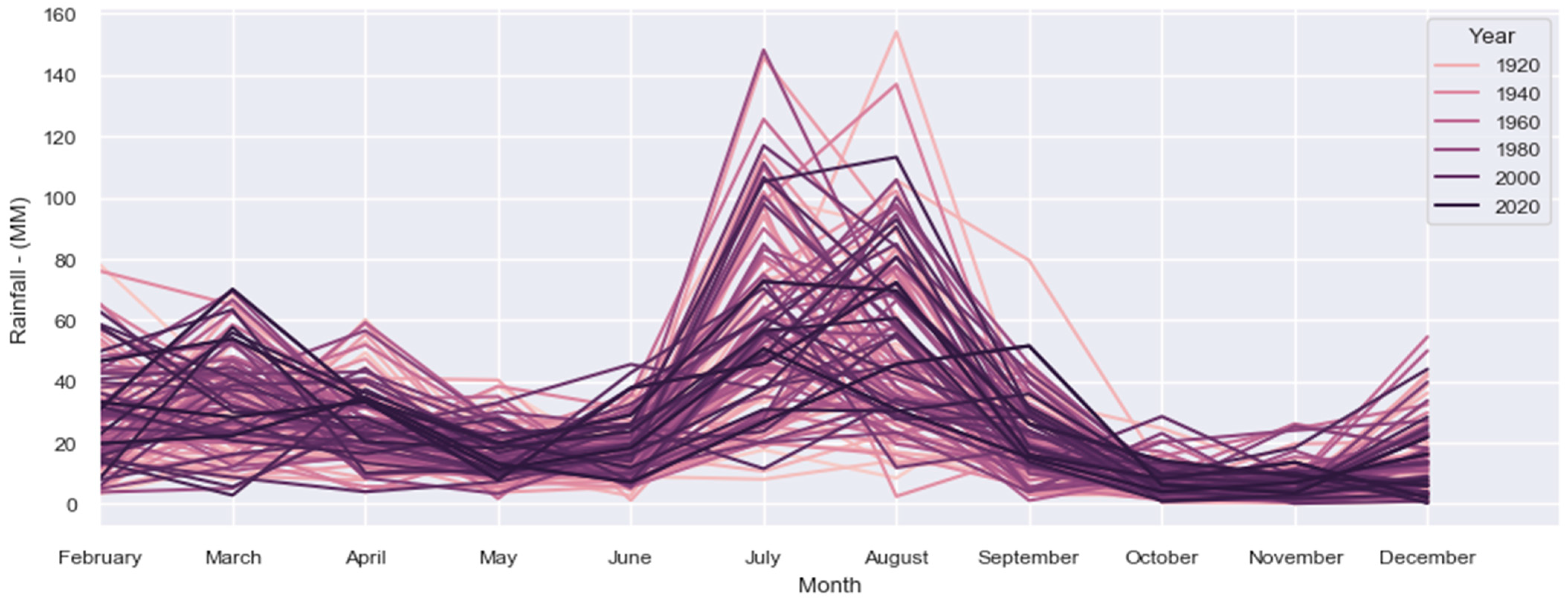

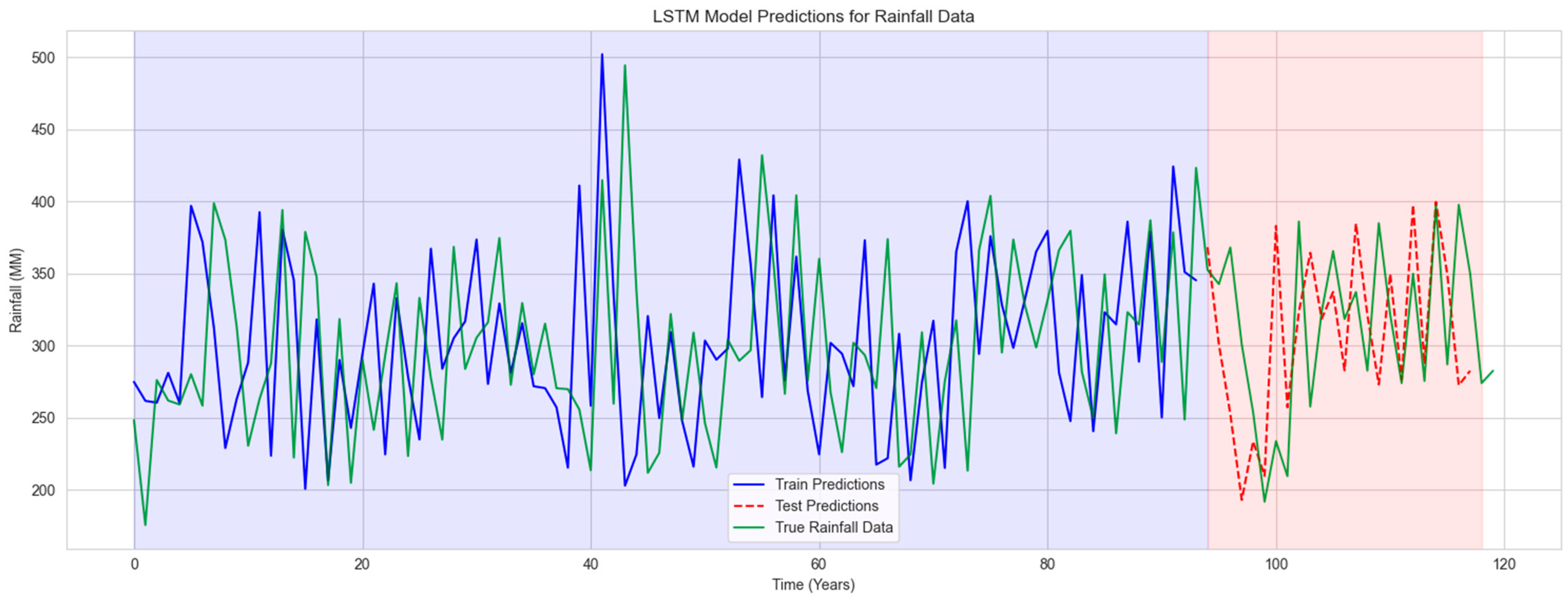
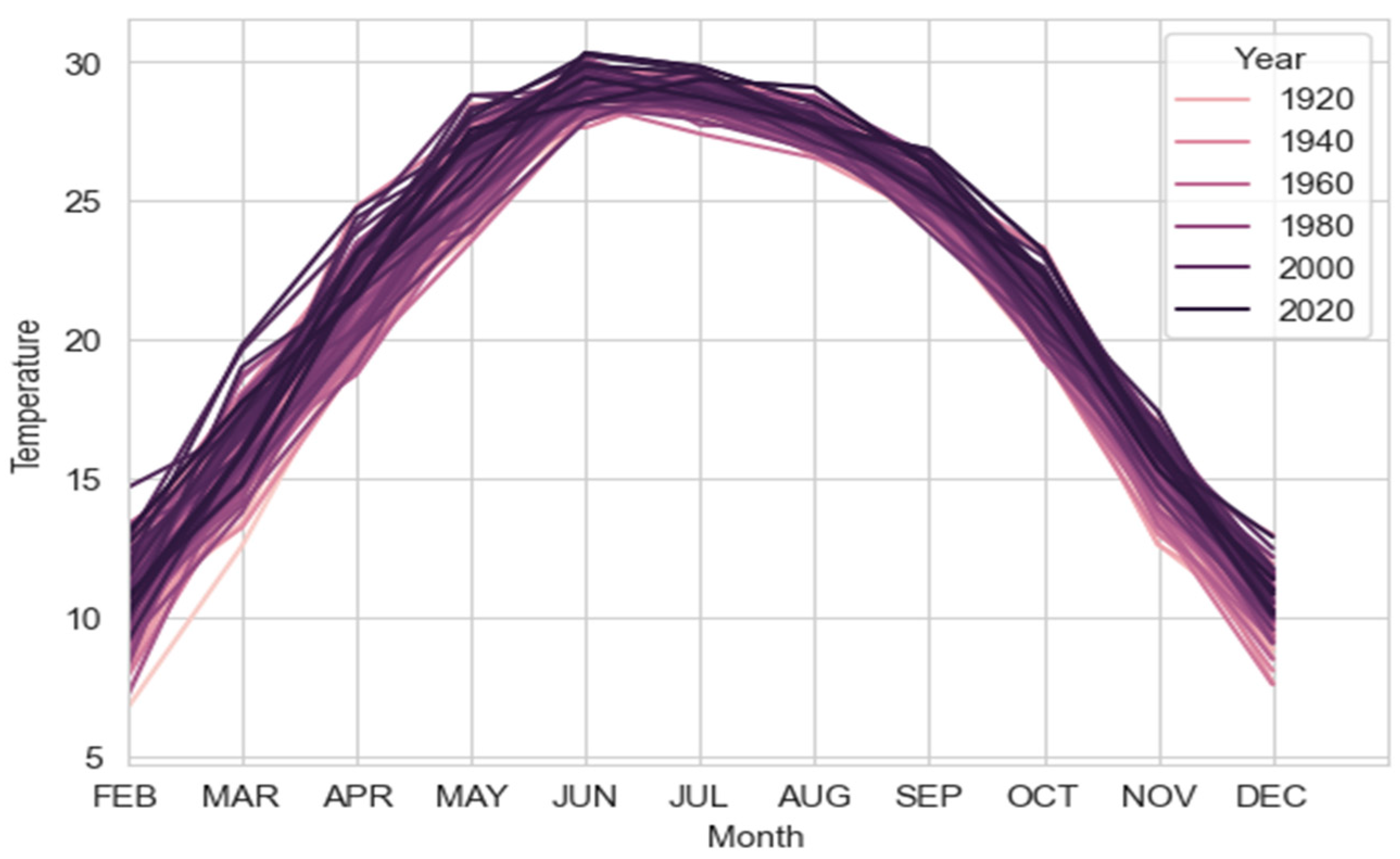
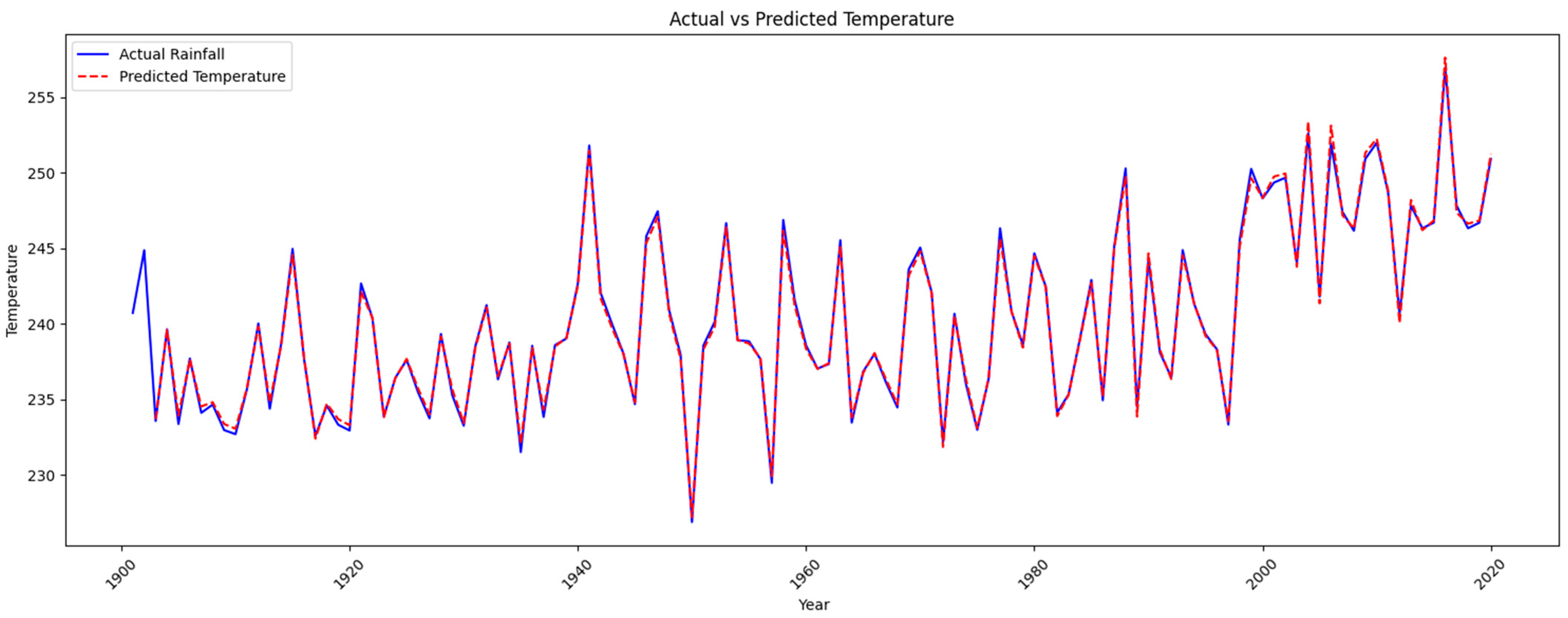
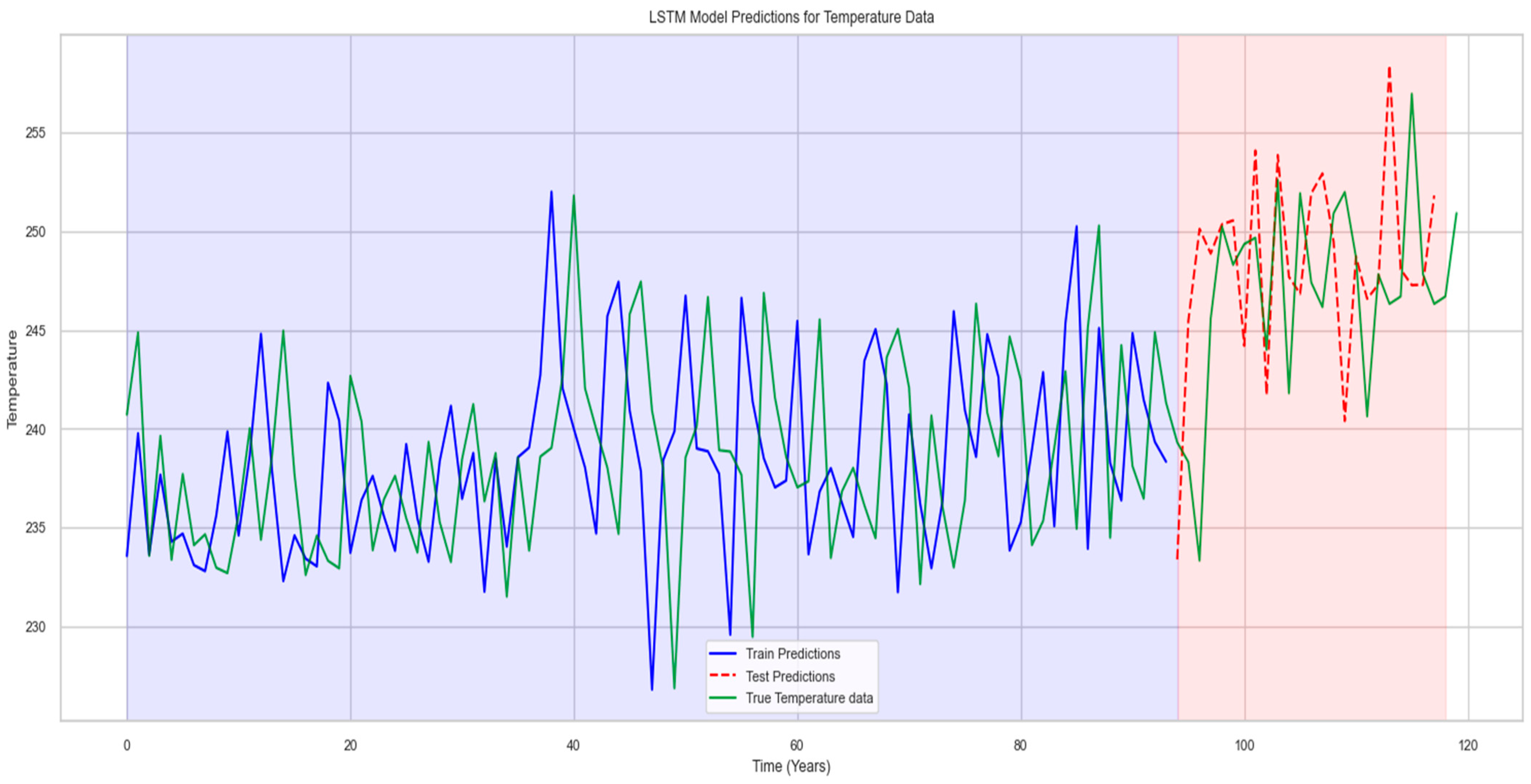
| LSTM Model | RMSE |
|---|---|
| Rainfall | 13 |
| Temperature | 15 |
| Water resources | 20 |
| Year | Surface Water Kharif | Groundwater Kharif | Surface Water Rabi | Groundwater Rabi | Total Water Availability |
| 2011 | 55.79 | 54.46 | 36.33 | 32.49 | 137.16 |
| 2012 | 62.93 | 57.61 | 31.53 | 28.04 | 135.86 |
| 2013 | 60.28 | 56.28 | 33.36 | 31.02 | 137.51 |
| 2014 | 59.60 | 54.52 | 34.39 | 30.06 | 134.58 |
| 2015 | 71.87 | 59.64 | 35.15 | 30.95 | 138.59 |
| 2016 | 68.02 | 52.85 | 34.80 | 29.15 | 133.00 |
| 2017 | 74.20 | 55.61 | 31.72 | 27.09 | 132.70 |
| 2018 | 72.54 | 56.05 | 25.97 | 25.35 | 133.40 |
| 2019 | 62.10 | 50.87 | 26.34 | 25.53 | 127.40 |
| 2020 | 67.87 | 52.68 | 30.70 | 27.52 | 130.00 |
| Year | Predicted Total Water Availability (Million Acre Feet) | ||||
| 2021 | 131.35 | ||||
| 2022 | 130.74 | ||||
| 2023 | 130.12 | ||||
| 2024 | 129.51 | ||||
| 2025 | 128.90 | ||||
| 2026 | 128.28 | ||||
| 2027 | 127.67 | ||||
| 2028 | 127.05 | ||||
| 2029 | 126.44 | ||||
| 2030 | 125.82 | ||||
Disclaimer/Publisher’s Note: The statements, opinions and data contained in all publications are solely those of the individual author(s) and contributor(s) and not of MDPI and/or the editor(s). MDPI and/or the editor(s) disclaim responsibility for any injury to people or property resulting from any ideas, methods, instructions or products referred to in the content. |
© 2024 by the authors. Licensee MDPI, Basel, Switzerland. This article is an open access article distributed under the terms and conditions of the Creative Commons Attribution (CC BY) license (https://creativecommons.org/licenses/by/4.0/).
Share and Cite
Shah, W.; Chen, J.; Ullah, I.; Shah, M.H.; Ullah, I. Application of RNN-LSTM in Predicting Drought Patterns in Pakistan: A Pathway to Sustainable Water Resource Management. Water 2024, 16, 1492. https://doi.org/10.3390/w16111492
Shah W, Chen J, Ullah I, Shah MH, Ullah I. Application of RNN-LSTM in Predicting Drought Patterns in Pakistan: A Pathway to Sustainable Water Resource Management. Water. 2024; 16(11):1492. https://doi.org/10.3390/w16111492
Chicago/Turabian StyleShah, Wilayat, Junfei Chen, Irfan Ullah, Muhammad Haroon Shah, and Irfan Ullah. 2024. "Application of RNN-LSTM in Predicting Drought Patterns in Pakistan: A Pathway to Sustainable Water Resource Management" Water 16, no. 11: 1492. https://doi.org/10.3390/w16111492
APA StyleShah, W., Chen, J., Ullah, I., Shah, M. H., & Ullah, I. (2024). Application of RNN-LSTM in Predicting Drought Patterns in Pakistan: A Pathway to Sustainable Water Resource Management. Water, 16(11), 1492. https://doi.org/10.3390/w16111492







